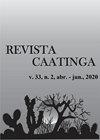考虑环境变异的普通大豆品系结构性状和产量性状的同时选择
IF 0.9
4区 农林科学
Q3 AGRONOMY
引用次数: 0
摘要
建立最小试验数可以提高植株构型和产量性状的同时选择效率,但对于普通豆,目前还没有这样的定义。本研究的目的是为几种植物结构和产量性状选择优良的普通大豆品系,并确定在同时选择农艺性状时提供更高效率的最小试验次数。通过4个试验对普通豆系的12个株型和5个产量性状进行了评价。利用单个试验I(2016年多雨)、II(2017年干旱)、III(2017年多雨)和IV(2018年旱季作物)的数据,或2个(I和II)、3个(I、II和III)和4个(I、II、III和IV)的数据进行方差分析和选择指数(乘性)分析。多数农艺性状表现出显著的基因型-试验互作效应。利用个体试验数据得出了可变的遗传率和遗传增益估计,并为每个生长环境选择了不同的普通豆基因型。然而,三到四个实验的数据表明,在选择四种优良的普通豆基因型时,LP 09-33、BRS Valente、p本文章由计算机程序翻译,如有差异,请以英文原文为准。
Simultaneous selection for architectural and yield traits in common bean lines considering environmental variability
ABSTRACT Simultaneous selection for plant architecture and yield traits will be more efficient if a minimum number of experiments is established, but no such definition has been made for common bean. The objectives of this study were to select superior common bean lines for several plant architecture and yield traits and identify the minimum number of experiments that provide greater efficiency in simultaneous selection for agronomic traits. Twelve plant architecture and five yield traits of common bean lines were evaluated in four experiments. Analysis of variance and selection index (multiplicative) were carried out using data from individual experiments I (2016 rainy), II (2017 dry), III (2017 rainy), and IV (2018 dry-season crops), or data from two (I and II), three (I, II, and III), and four (I, II, III, and IV) experiments. Most agronomic traits showed a significant genotype × experiment interaction effect. The use of data from individual experiments resulted in variable heritability and genetic gain estimates and in the selection of different common bean genotypes for each growing environment. However, data from three or four experiments allowed 100% of coincidence in the selection of four superior common bean genotypes: LP 09-33, BRS Valente, Pérola, and Carioca. Data from at least three experiments should be used to select superior common bean lines for plant architecture and yield traits to increase the efficiency of simultaneous selection.
求助全文
通过发布文献求助,成功后即可免费获取论文全文。
去求助
来源期刊

Revista Caatinga
AGRONOMY-
CiteScore
2.10
自引率
11.10%
发文量
67
审稿时长
6-12 weeks
期刊介绍:
A Revista Caatinga é uma publicação científica que apresenta periodicidade trimestral, publicada pela Pró-Reitoria de Pesquisa e Pós-Graduação da Universidade Federal Rural do Semi-Árido – UFERSA, desde 1976.
Objetiva proporcionar à comunidade científica, publicações de alto nível nas áreas de Ciências Agrárias e Recursos Naturais, disponibilizando, integral e gratuitamente, resultados relevantes das pesquisas publicadas.
 求助内容:
求助内容: 应助结果提醒方式:
应助结果提醒方式:


